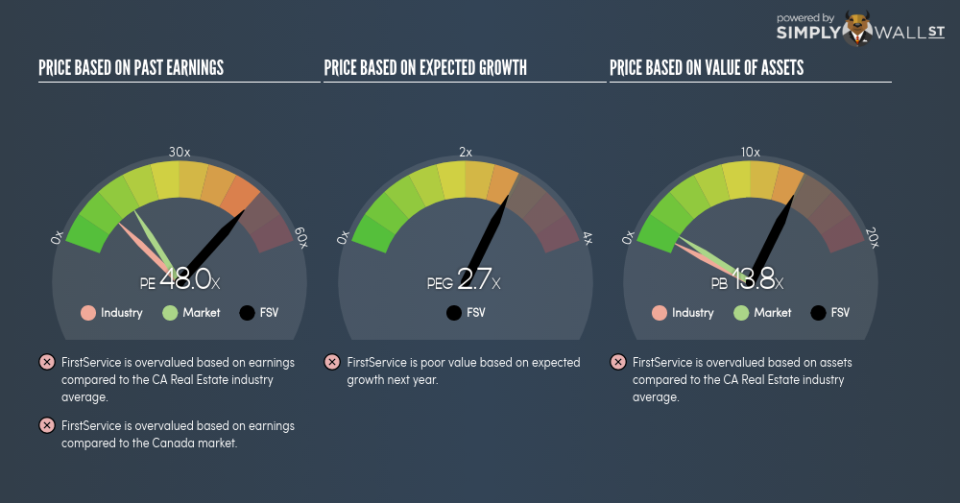Does FirstService Corporation’s (TSE:FSV) PE Ratio Signal A Selling Opportunity?

This article is intended for those of you who are at the beginning of your investing journey and want to begin learning the link between FirstService Corporation (TSE:FSV)’s fundamentals and stock market performance.
FirstService Corporation (TSE:FSV) is currently trading at a trailing P/E of 48x, which is higher than the industry average of 10.5x. While this makes FSV appear like a stock to avoid or sell if you own it, you might change your mind after I explain the assumptions behind the P/E ratio. In this article, I will deconstruct the P/E ratio and highlight what you need to be careful of when using the P/E ratio. See our latest analysis for FirstService
Demystifying the P/E ratio
The P/E ratio is a popular ratio used in relative valuation since earnings power is a key driver of investment value. By comparing a stock’s price per share to its earnings per share, we are able to see how much investors are paying for each dollar of the company’s earnings.
P/E Calculation for FSV
Price-Earnings Ratio = Price per share ÷ Earnings per share
FSV Price-Earnings Ratio = $73.25 ÷ $1.528 = 48x
The P/E ratio isn’t a metric you view in isolation and only becomes useful when you compare it against other similar companies. We want to compare the stock’s P/E ratio to the average of companies that have similar characteristics as FSV, such as size and country of operation. A quick method of creating a peer group is to use companies in the same industry, which is what I will do. FSV’s P/E of 48x is higher than its industry peers (10.5x), which implies that each dollar of FSV’s earnings is being overvalued by investors. Therefore, according to this analysis, FSV is an over-priced stock.
Assumptions to be aware of
However, before you rush out to sell your FSV shares, it is important to note that this conclusion is based on two key assumptions. Firstly, our peer group contains companies that are similar to FSV. If this isn’t the case, the difference in P/E could be due to other factors. For example, if you compared higher growth firms with FSV, then its P/E would naturally be lower since investors would reward its peers’ higher growth with a higher price. The second assumption that must hold true is that the stocks we are comparing FSV to are fairly valued by the market. If this does not hold, there is a possibility that FSV’s P/E is lower because our peer group is overvalued by the market.
What this means for you:
Since you may have already conducted your due diligence on FSV, the overvaluation of the stock may mean it is a good time to reduce your current holdings. But at the end of the day, keep in mind that relative valuation relies heavily on critical assumptions I’ve outlined above. Remember that basing your investment decision off one metric alone is certainly not sufficient. There are many things I have not taken into account in this article and the PE ratio is very one-dimensional. If you have not done so already, I highly recommend you to complete your research by taking a look at the following:
Future Outlook: What are well-informed industry analysts predicting for FSV’s future growth? Take a look at our free research report of analyst consensus for FSV’s outlook.
Past Track Record: Has FSV been consistently performing well irrespective of the ups and downs in the market? Go into more detail in the past performance analysis and take a look at the free visual representations of FSV’s historicals for more clarity.
Other High-Performing Stocks: Are there other stocks that provide better prospects with proven track records? Explore our free list of these great stocks here.
To help readers see pass the short term volatility of the financial market, we aim to bring you a long-term focused research analysis purely driven by fundamental data. Note that our analysis does not factor in the latest price sensitive company announcements.
The author is an independent contributor and at the time of publication had no position in the stocks mentioned.

